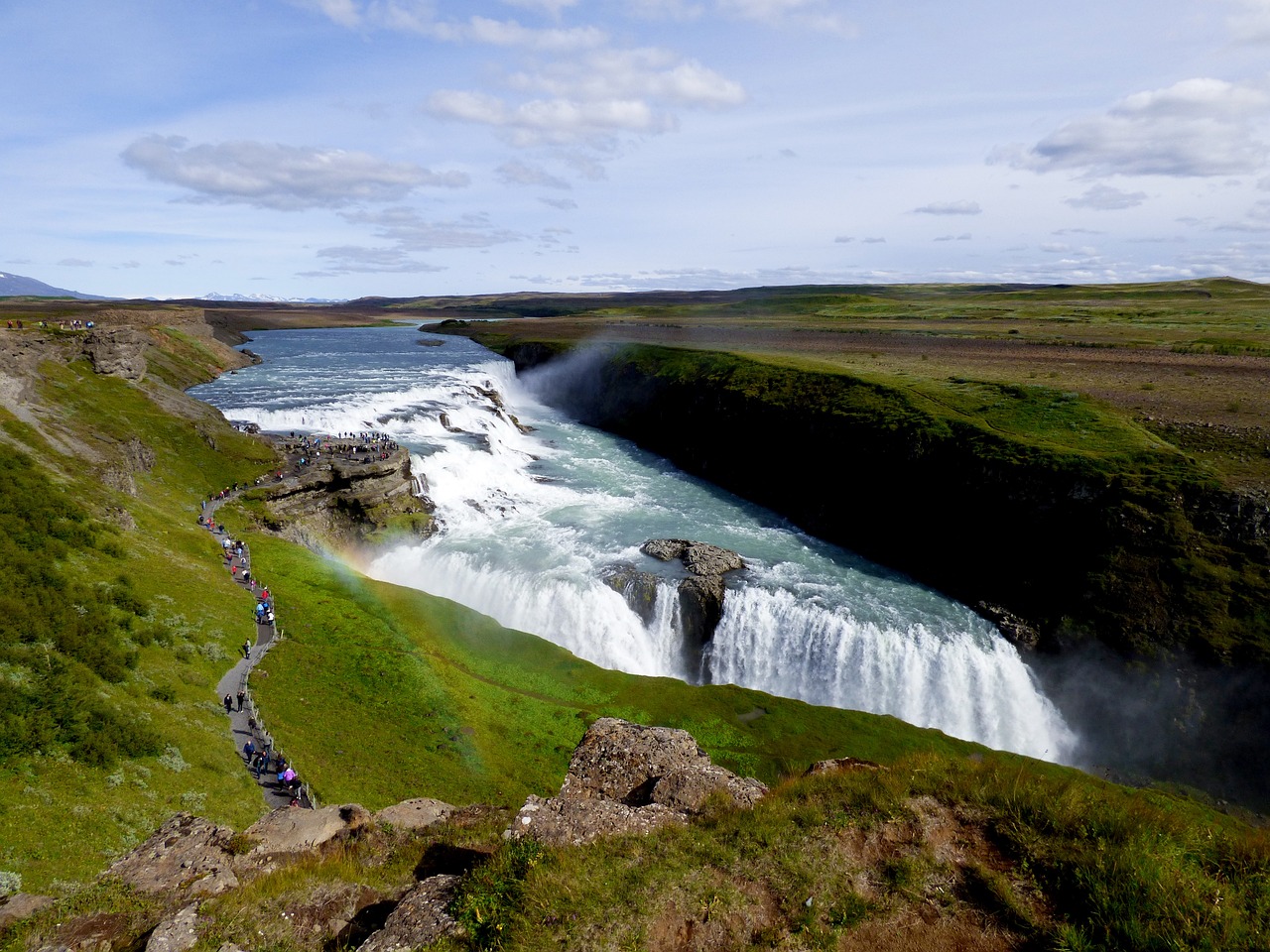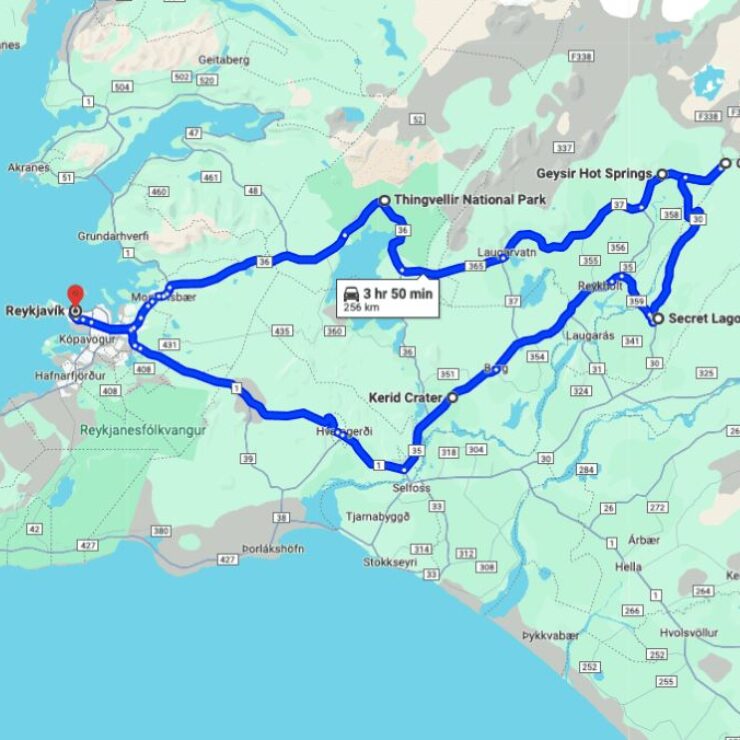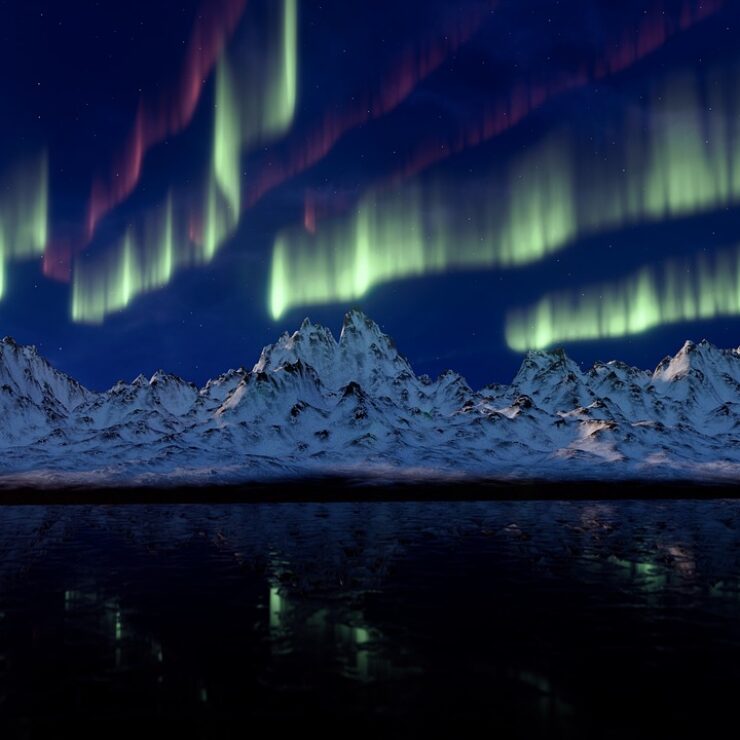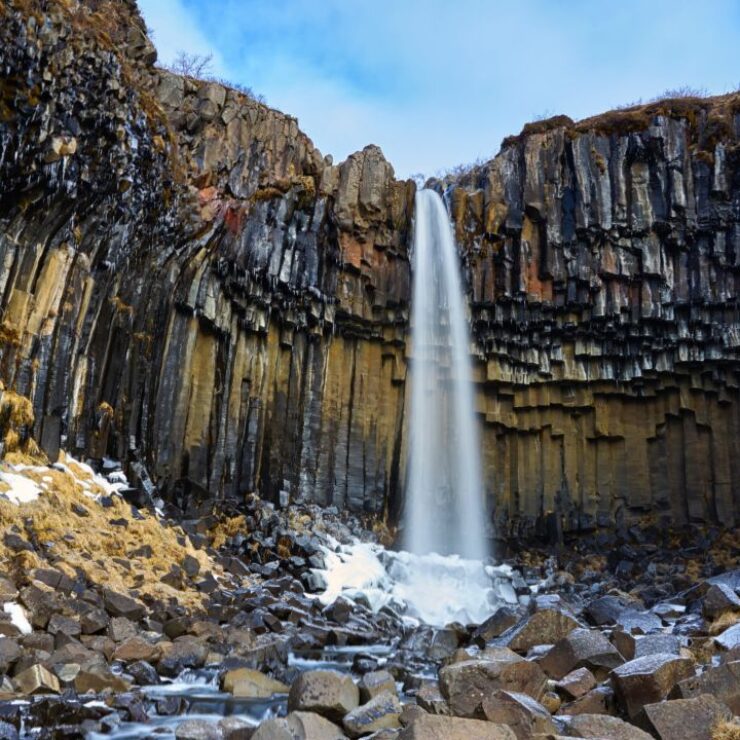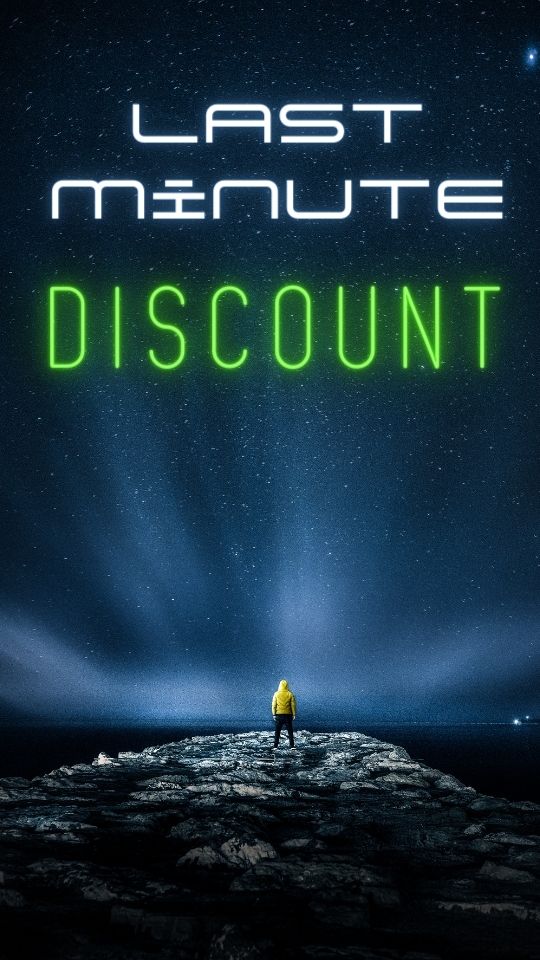Gullfoss Waterfall, also known as the “Golden Falls,” is an awe-inspiring natural wonder located in Southwest Iceland. With its majestic two-tiered cascade, Gullfoss is considered one of the country’s most iconic and beloved waterfalls. In this comprehensive guide, we will explore the history, geography, and unique features of Gullfoss, as well as provide practical information for visiting this breathtaking attraction.
1. Introduction to Gullfoss Waterfall
Gullfoss, meaning “Golden Falls” in Icelandic, is a captivating waterfall situated in the Hvítá river canyon. It is a prominent stop along the popular Golden Circle sightseeing route, which also includes the Geysir geothermal area and Þingvellir National Park. The waterfall’s name is derived from the golden hue that the glacial water takes on as it plunges down the cascades.
Gullfoss is a tiered waterfall that drops a total of 32 meters (105 feet) into a dramatic and narrow canyon. The falls are actually composed of two separate drops, with the first cascade measuring 11 meters (36 feet) and the second drop measuring 21 meters (69 feet). The sheer power and beauty of Gullfoss make it a must-see destination for nature lovers and adventure enthusiasts visiting Iceland.
2. The Formation and Geography of Gullfoss
Gullfoss waterfall was formed during the last ice age, approximately 5,000 years ago. The waters of the Hvítá river, which originates from the Langjökull glacier, carve their way through the rugged landscape, creating the stunning canyon that houses Gullfoss. The canyon stretches over 2.5 kilometers (1.6 miles) and reaches depths of up to 70 meters (230 feet).
As the Hvítá river flows southward, it takes a sharp turn near Gullfoss and plummets into the canyon in a series of cascades. The force of the water creates a mesmerizing display of raw power, with the spray from the falls often forming rainbows on sunny days. The glacial meltwater gives Gullfoss its distinctive golden color, adding to its allure.
3. The Legend of Sigríður Tómasdóttir and the Conservation of Gullfoss
Gullfoss holds a significant place in Icelandic history, thanks to the efforts of Sigríður Tómasdóttir. In the early 20th century, foreign investors sought to exploit the waterfall’s potential for hydroelectric power generation. Sigríður, the daughter of the farmer who owned the land surrounding Gullfoss, vehemently opposed these plans and fought tirelessly to protect the waterfall.
Legend has it that Sigríður even threatened to throw herself into the waterfall if the construction of a power plant proceeded. Her determination and unwavering commitment to preserving Gullfoss eventually led to the cancellation of the lease agreement with the foreign investors. In 1940, Sigríður’s adopted son acquired the waterfall and later sold it to the Icelandic government, ensuring its long-term conservation.
Today, a memorial stone dedicated to Sigríður Tómasdóttir stands near Gullfoss, commemorating her courageous efforts to safeguard this natural treasure. Her legacy as Iceland’s first environmentalist lives on, and visitors can pay tribute to her by appreciating and respecting the beauty of Gullfoss.
“I will not sell my friend!” – Tómas Tómasson, owner of Gullfoss, in response to an English businessman’s offer to purchase the waterfall.
4. Gullfoss in Different Seasons: A Visual Spectacle
Gullfoss offers a unique and captivating experience throughout the year, with each season showcasing its own distinct charm. In the summer months, the glacial meltwater from Langjökull glacier swells the Hvítá river, resulting in a powerful torrent of water rushing over the falls. The spray from the cascades creates a mesmerizing mist that often forms rainbows, adding an ethereal touch to the landscape.
During the winter, Gullfoss undergoes a stunning transformation as the freezing temperatures turn the waterfall into an icy wonderland. The water that flows over the falls gradually freezes, forming intricate ice formations and icicles that shimmer in the sunlight. The frozen landscape surrounding Gullfoss adds to the dramatic beauty of the waterfall, making it a popular destination for winter adventurers and photographers.
No matter the season, Gullfoss never fails to impress with its sheer size, power, and natural beauty. Whether you witness the waterfall in its summer splendor or marvel at its frozen magnificence in winter, Gullfoss promises an unforgettable experience.
5. Getting to Gullfoss: Access and Transportation Options
Gullfoss is conveniently located within easy reach from Reykjavik, making it a popular day trip destination for both locals and tourists. The waterfall is situated on the Golden Circle route, a well-known tourist circuit that encompasses several of Iceland’s most remarkable natural attractions.
5.1 Driving to Gullfoss
Driving to Gullfoss is a straightforward option, and the route from Reykjavik is well-marked. From the capital city, head east on the Ring Road (Route 1) and follow the signs for the Golden Circle. After approximately 54 kilometers (34 miles), take a right turn onto Route 35, which leads directly to Gullfoss. The journey from Reykjavik to Gullfoss takes approximately 1 hour and 30 minutes.
The road leading to Gullfoss is well-maintained, especially considering its Arctic location. Visitors can expect smooth and pothole-free roads, making self-driving an accessible and enjoyable option. However, it is essential to exercise caution and drive carefully, especially during winter when the weather conditions can be challenging. Always check the weather forecast and road conditions before embarking on your journey.
5.2 Guided Tours to Gullfoss
For those who prefer not to drive or want a more immersive experience, guided tours to Gullfoss are widely available. Various tour operators offer Golden Circle tours that include stops at Gullfoss, along with other popular attractions such as the Geysir geothermal area and Þingvellir National Park. These tours provide informative commentary from knowledgeable guides and allow you to sit back, relax, and enjoy the scenery.
Additionally, there are tour packages specifically designed for adventure seekers, such as snowmobiling or hiking tours that combine Gullfoss with thrilling activities in the surrounding area. These tours offer a unique perspective of Gullfoss and allow you to explore the natural wonders of Iceland in a more immersive way.
6. Exploring the Surrounding Area: Other Attractions Near Gullfoss
Gullfoss is not the only breathtaking attraction in the vicinity. The Golden Circle route offers a wealth of natural wonders and cultural landmarks that are worth exploring during your visit to Gullfoss. Here are some notable attractions near Gullfoss:
6.1 Geysir Geothermal Area
The Geysir geothermal area, located approximately 10 kilometers (6 miles) from Gullfoss, is home to the famous Strokkur geyser. Strokkur erupts every few minutes, shooting scalding water high into the air, providing a thrilling spectacle for visitors. The geothermal area also features bubbling mud pots and other geothermal phenomena, offering a unique glimpse into Iceland’s volcanic landscape.
6.2 Þingvellir National Park
Þingvellir National Park, a UNESCO World Heritage Site, is an essential stop on the Golden Circle route. The park holds significant historical and cultural importance, as it was the site of Iceland’s first parliament, established in 930 AD. In addition to its historical significance, Þingvellir is renowned for its stunning natural beauty, including the Silfra fissure, where visitors can snorkel or dive between the tectonic plates of North America and Eurasia.
6.3 Faxi Waterfall
Located a short distance from Gullfoss, Faxi waterfall is another hidden gem worth visiting. Although smaller in scale compared to Gullfoss, Faxi offers a tranquil and picturesque setting. Visitors can admire the waterfall from various viewpoints and enjoy the peaceful surroundings.
These are just a few examples of the attractions near Gullfoss that you can explore during your visit. Each of these sites offers a unique experience and adds to the overall beauty and richness of the Golden Circle route.
7. Activities and Adventures at Gullfoss
Gullfoss not only captivates visitors with its natural beauty but also offers a range of activities and adventures for those seeking a more immersive experience. Here are some exciting options to consider when visiting Gullfoss:
7.1 River Rafting on the Hvítá River
The Hvítá River, which flows through Gullfoss, provides an exhilarating opportunity for river rafting. Adventurous souls can embark on a thrilling rafting trip down the river’s rapids, experiencing the power of the glacial waters firsthand. Guided tours are available, catering to different skill levels, making it an adrenaline-pumping activity for both beginners and experienced rafters.
7.2 Snowmobiling on the Langjökull Glacier
For a truly unforgettable experience, consider embarking on a snowmobiling adventure on the nearby Langjökull Glacier. Guided tours allow you to explore the vast icy expanse, riding across the glacier’s pristine surface and marveling at the breathtaking panoramic views. This thrilling activity combines the beauty of the Icelandic landscape with an adrenaline-fueled adventure.
7.3 Hiking and Nature Walks
Gullfoss and its surrounding area offer excellent opportunities for hiking and nature walks. There are several marked trails that allow you to explore the stunning landscapes at your own pace. Whether you prefer short walks to viewpoints or longer hikes through the rugged terrain, there is something for everyone to enjoy.
These are just a few examples of the activities and adventures that await you at Gullfoss. Whether you choose to experience the thrill of river rafting, the exhilaration of snowmobiling, or the tranquility of a nature walk, Gullfoss promises to be a destination that caters to your sense of adventure.
8. Safety Tips and Responsible Tourism at Gullfoss
While Gullfoss is a mesmerizing natural attraction, it is crucial to prioritize safety and practice responsible tourism during your visit. Here are some important safety tips to keep in mind:
- Stay on designated paths and trails: Respect the natural environment and stick to the designated paths when exploring Gullfoss and its surroundings. Straying off the marked trails can cause irreversible damage to the delicate ecosystem.
- Follow all safety signs and warnings: Pay attention to any safety signs or warnings posted in the area. These signs are in place to ensure your safety and protect the natural beauty of Gullfoss.
- Be aware of changing weather conditions: Iceland’s weather can be unpredictable, so it is essential to check the forecast before your visit and be prepared for changing conditions. Dress in layers, wear sturdy footwear, and bring appropriate gear for the season.
- Practice responsible waste management: Help keep Gullfoss and its surroundings pristine by disposing of any waste properly. Use designated bins and recycling facilities, and avoid leaving any litter behind.
- Respect wildlife and vegetation: Be mindful of the fragile ecosystem at Gullfoss and refrain from disturbing or feeding wildlife. Avoid trampling on vegetation and leave nature as you found it.
By following these safety tips and practicing responsible tourism, you can ensure a safe and enjoyable experience at Gullfoss while preserving its natural beauty for future generations.
9. Best Time to Visit Gullfoss: Tips and Recommendations
Gullfoss is a year-round destination, each season offering its own unique charm. Here are some tips to help you plan your visit to Gullfoss:
9.1 Summer (June to August)
During the summer months, Gullfoss is at its most spectacular, with the glacial meltwater flowing in full force. The longer daylight hours provide ample time to explore the area and capture stunning photographs. However, summer is also the peak tourist season, so expect larger crowds. To avoid the busiest times, consider visiting early in the morning or later in the evening.
9.2 Winter (December to February)
Winter transforms Gullfoss into a magical wonderland, with the freezing temperatures creating ice formations that shimmer in the sunlight. Visiting Gullfoss in winter offers a quieter and more serene experience, with fewer tourists. However, be aware that weather conditions can be harsh, and access to certain viewpoints may be restricted due to ice and snow. Dress warmly and be prepared for icy surfaces.
9.3 Shoulder Seasons (Spring and Autumn)
Spring (March to May) and autumn (September to November) offer a balance between the summer and winter seasons. The landscapes are often adorned with vibrant colors, and the weather is milder compared to the extremes of summer and winter. These seasons offer a quieter atmosphere and are ideal for those seeking a more tranquil experience.
No matter the time of year, Gullfoss promises a captivating experience. Consider your preferences for crowd levels, weather conditions, and the unique features of each season when planning your visit.
10. Nearby Accommodations and Dining Options
While Gullfoss itself does not have on-site accommodations or dining facilities, there are several options available in the surrounding area to enhance your visit. Here are some recommendations:
10.1 Accommodations
- Hotel Gullfoss: Located just a short distance from the waterfall, Hotel Gullfoss offers comfortable rooms and stunning views of the surrounding landscapes.
- Geysir Cottages: Situated near the Geysir geothermal area, Geysir Cottages provide cozy and well-equipped accommodations in a picturesque setting.
- Self-catering Accommodations: If you prefer a more independent experience, consider booking a self-catering cottage or apartment in the nearby towns of Reykholt or Laugarvatn.
10.2 Dining Options
- Gullfoss Café: Adjacent to Gullfoss Waterfall, Gullfoss Café offers a variety of refreshments, including hot soups, sandwiches, salads, and traditional Icelandic cakes.
- Fridheimar: Located near the Geysir area, Fridheimar is a unique dining experience where you can enjoy a meal surrounded by tomato plants in a greenhouse. Their menu features delicious dishes made with locally grown tomatoes.
These are just a few options for accommodations and dining near Gullfoss. It is advisable to make reservations in advance, especially during peak tourist seasons.
11. Photography Tips for Capturing the Beauty of Gullfoss
Gullfoss provides a stunning backdrop for photography enthusiasts. Here are some tips to help you capture the beauty of this magnificent waterfall:
- Visit during golden hour: The soft, warm light during the hour after sunrise and before sunset can enhance the colors and textures of Gullfoss. Plan your visit accordingly to make the most of this magical time.
- Experiment with different angles: Gullfoss offers a range of viewpoints, so don’t be afraid to explore different angles and compositions. Consider capturing the waterfall from above, below, or from various perspectives along the footpath.
- Use a polarizing filter: A polarizing filter can help reduce glare and enhance the colors of the landscape. It can also help capture the rainbows that often form in the mist of Gullfoss.
- Include foreground elements: Incorporate elements in the foreground, such as rocks or vegetation, to add depth and interest to your photographs.
- Long exposure techniques: Experiment with long exposure photography to create a smooth, ethereal effect on the cascading water. Use a tripod to ensure stability and adjust your shutter speed accordingly.
Remember to respect the environment and other visitors while capturing your photographs. Be mindful of your surroundings and follow any guidelines or restrictions in place.
12. Conclusion: Gullfoss, a Must-See Wonder of Iceland
Gullfoss Waterfall is a testament to the raw power and beauty of nature. With its captivating two-tiered cascade, rich history, and stunning surroundings, Gullfoss is a must-see destination for anyone visiting Iceland. Whether you witness the waterfall in its summer splendor or marvel at its frozen magnificence in winter, Gullfoss promises an awe-inspiring experience that will leave a lasting impression.
From the conservation efforts of Sigríður Tómasdóttir to the activities and adventures available in the area, Gullfoss offers a range of experiences for every traveler. Explore the surrounding attractions, embark on thrilling adventures, and immerse yourself in the breathtaking landscapes of Southwest Iceland.
As you visit Gullfoss, remember to prioritize safety, practice responsible tourism, and respect the natural beauty of this iconic waterfall. Capture its beauty through photography, but also take a moment to simply stand in awe of the majesty and power of Gullfoss.
Plan your visit to Gullfoss Waterfall today and embark on an unforgettable journey into the heart of Iceland’s natural wonders.

